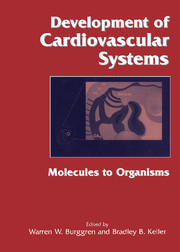Book contents
- Frontmatter
- Contents
- List of contributors
- Foreword by Constance Weinstein
- Introduction: Why study cardiovascular development?
- Part I Molecular, cellular, and integrative mechanisms determining cardiovascular development
- Part II Species diversity in cardiovascular development
- 9 Evolution of cardiovascular systems: Insights into ontogeny
- 10 Morphogenesis of vertebrate hearts
- 11 Invertebrate cardiovascular development
- 12 Piscine cardiovascular development
- 13 Amphibian cardiovascular development
- 14 Reptilian cardiovascular development
- 15 Avian cardiovascular development
- 16 Mammalian cardiovascular development: Physiology and functional reserve of the fetal heart
- Part III Environment and disease in cardiovascular development
- Epilogue: Future directions in developmental cardiovascular sciences
- References
- Systematic index
- Subject index
15 - Avian cardiovascular development
from Part II - Species diversity in cardiovascular development
Published online by Cambridge University Press: 10 May 2010
- Frontmatter
- Contents
- List of contributors
- Foreword by Constance Weinstein
- Introduction: Why study cardiovascular development?
- Part I Molecular, cellular, and integrative mechanisms determining cardiovascular development
- Part II Species diversity in cardiovascular development
- 9 Evolution of cardiovascular systems: Insights into ontogeny
- 10 Morphogenesis of vertebrate hearts
- 11 Invertebrate cardiovascular development
- 12 Piscine cardiovascular development
- 13 Amphibian cardiovascular development
- 14 Reptilian cardiovascular development
- 15 Avian cardiovascular development
- 16 Mammalian cardiovascular development: Physiology and functional reserve of the fetal heart
- Part III Environment and disease in cardiovascular development
- Epilogue: Future directions in developmental cardiovascular sciences
- References
- Systematic index
- Subject index
Summary
Introduction
There are more than 8550 avian species, and egg size ranges from not more than 1 g to about 1500 g. Depending on embryonic maturity at hatching, birds are grouped into two classes: altricial (embryos hatch with naked bodies, with closed eyes, and without the abilities of locomotion and thermoregulation) and precocial (hatchlings can walk, swim, or dive shortly after hatching). Despite the wide variety of avian eggs, however, study of avian embryonic cardiovascular systems has been limited primarily to domesticated birds, with emphasis on the chick (Gallus domesticus) embryo.
An incubation temperature of about 38°C is adequate for the growth of the chick embryo, which hatches on day 21 of incubation. As the embryo grows, the cardiovascular system develops rapidly. Because of the restricted locomotion of embryos within the confines of the eggshell, rapid development of the cardiovascular system, and easy acquisition of fertile eggs year-round, the chicken egg provides an excellent experimental animal model for the study of the development of cardiac and vascular regulation (see Chapters 7, 8, 10, and 19). Also, during the last half of incubation, it becomes possible to measure some physiological variables from developing embryos without impeding gas exchange through the eggshell.
This chapter describes (1) the development of chick embryos, especially their hearts, (2) developmental patterns of circulatory parameters during the period of rapid embryonic growth prior to pipping, and (3) a model analysis of cardiovascular shunts of a late embryo.
The developmental time of chick embryos varies, probably depending upon strains, fresh egg mass, shell porosity, and slight differences in incubation temperature (Romanoff, 1960a; Tullett & Burton, 1982; Zhang & Whittow, 1992).
Information
- Type
- Chapter
- Information
- Development of Cardiovascular SystemsMolecules to Organisms, pp. 193 - 210Publisher: Cambridge University PressPrint publication year: 1998
Accessibility standard: Unknown
Why this information is here
This section outlines the accessibility features of this content - including support for screen readers, full keyboard navigation and high-contrast display options. This may not be relevant for you.Accessibility Information
- 3
- Cited by
